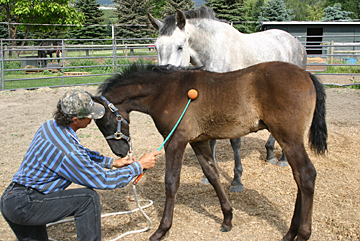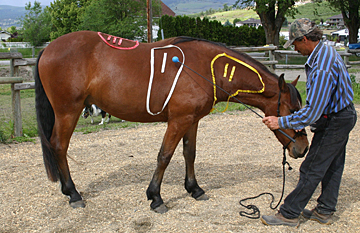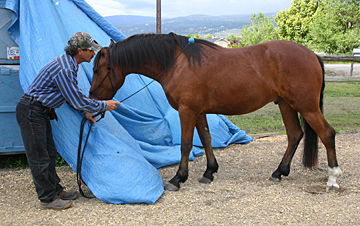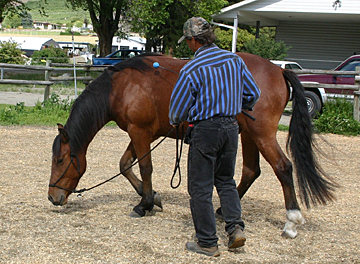by Paul Dufresne
A few young gals were having difficulty with stiff, anxious horses. These young, smaller participants were struggling to employ good leadership because of the safety issues in potentially being over-powered by their horses. I got them started on softening on the bend and basic yields but these horses needed more attention. Some of my advanced students were there to audit and were asked to help. These gals had experience with endotapping and used the technique to facilitate the acceptance and well being of these horses. The coolest part was that they then showed these junior leads how to do it themselves. Too often we think people can’t learn something because because they lack experience. WRONG. These young gals understood the basic idea quickly and their horses were responding positively shortly thereafter.
So what is ENDOTAPPING? When people watch me tapping a horse with an odd looking whip with a ball on the end of it, the eyes of skeptics light up with that, “Yeah right...hocus pocus” look! In about an hour though, that skepticism changes to disbelief with lots of eye rubbing! When participants and auditors watch horses that are pushy, stiff, anxiously explosive or implosive find a relaxed state and a willingness to try for their lead, the changes speak for themselves. They can’t ignore the results even if they don’t understand exactly what is going on. Endotapping is a physical stimulation of the horse’s neuromuscular network with a ball whip which causes a neurohormonal release (endorphins would be my guess). This is further enhanced or facilitated by controlling the bend or shape of the horse. The tapping progressively develops into a cue that can be used any time the horse is anxious. The technique can be successfully applied on large general areas of the body which allows most people, including children or physically challenged, to cause a positive change in the horses.
Why is this technique so significant? Quite simply a horse is equipped with a very quick mechanism to get into adrenalin surges any time it has to prepare for flight as a prey animal. Endotapping interrupts that fear/excite cycle. Some horses have highly-active startle responses such as sensitivity to sounds, shaking, repeated snorting, irregular breathing, bug-eyed, sweating and high headedness. I am sure you have seen such horses, stuck in a cycle of fear. Some horses can discern readily between situations that are threatening or not. Other horses are poorly equipped to deal with our human environment. A horse that is calm is always easier to lead and much safer to be around.
For me the first use of the ball whip is to cause the horse to feel good so it is more likely to understand anything else I try to teach it or wish to have it accept without fear. Anytime I find the horse getting worried I would tap it and reset the feel good in the horse, only progressing once calm has been re-established. For horses that have been abused or simply find it hard to cope around humans, this can be incredibly useful in setting the foundation for a positive experience without so much struggle. If we feel good we will always be more receptive to a new situation or challenge. As a leader this gives you something very important and desirable to the horse a “positive emotional state”.
Endotapping can produce a positive emotional state so that teaching can begin - bombproofing -softer yields - control of the poll - enhance quality of gaits - walk, trot, canter softness and control - prepare for more complex movements - therapy for rehabilitation from injury or disease or to finish a session.
I start Endotapping on the horse with it standing still, but if the horse is unsure and wishes to move I would allow it. Restricting it would only reinforce the fear of something that it does not understand or feeling trapped. Give pressure on a short lead, asking the horse to bend slightly to the side you are standing. Keep the horse’s eye from looking to the opposite side as this leads to short circuiting the reflex. Tap the horse with the ball whip rhythmically and repetitively beginning with a softer tap (but not so soft that it tickles) then progressing to a firmer tap.
The first target area with the ball whip is the general area where your leg would hang when riding. Any sort of regular rhythm will work. Changing the rhythm or intensity is a great way to cause the horse to pay attention to you if it gets distracted. Once you can get the horse to start salivating, chewing, wanting to keep its head down in a relaxed way with soft eyes and loose muscle tone on the face and muzzle, you can then ask the horse to move forward on a circle at a walk tapping the horse anytime it chooses to travel with its head long and low loose at the poll. If the horse should want to rush or get anxious you could affect a mini sweep, opening the leadline to start the haunches crossing under and then elevating the lead line so the horse also carries the cross over and bend all the way to the forehand. As it slows, you could tap it again until it relaxes.
You should then try to do this in a soft jog. Any time the horse gets excited, slow it down or stop it, then endotapping to regain the feel good and then starting again. Later this can also be done at the canter but the walk and trot are already a great start.
Endotapping is an incredible asset when starting bomb-proofing. Any time we introduce a stressor and the horse begins to display signs of anxiety we can diffuse it by tapping the horse to regain the feel good. You could use the advance retreat method but, in most cases, by diffusing the anxiousness the horse overcomes such situations rather quickly. Again each horse is different and may be more sensitive to all or some types of stressors. If you have developed very good cues with the tapping, in most cases you will speed up the horse’s acceptance of any stimuli.
In the follow-up segments on endotapping, I will discuss the development of softer yields, controlling the poll, gait transitions with softness and balanced control preparing for more complex movements as well as its use in rehabilitation therapy for injury or disease. Endotapping is always a great way to end a play/training session by getting your partner in a great relaxed state. Try tapping in many places all over its body to see what your horse enjoys.

Two month old colt, never tapped before, with a good start
with head down and relaxing with hardly any halter
training.

Target tapping areas zone 1 2 3 in order of importance

Tapping to calm while accepting going to tarp on trailer (blowing a bit)

Accepting the tarp blowing on him

Tapping on a circle at a relaxed walk.
trainers and clinicians modify techniques to suit their needs, and the needs of their students - both human or equine. This
technique, when combined with shape control and Natural Horsemanship, I have found to be an exceptional
way to lead a horse and facilitate a very healthy partnership.